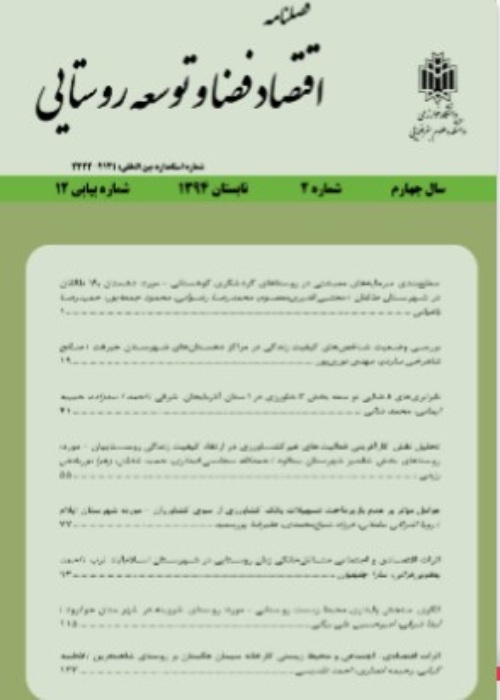Analysis of effective factors on tendency to development of the units of rural dairy in Khorramabad
Animal husbandry and livestock raising as the most important agricultural sub-sector reduces poorest peoplechr('39')s vulnerability all over the world by providing them a "food safety network". In this regard, ranchers are facing key challenges such as low yields of cattle, lack and fragmentation of pasture, water shortage and need to irrigate pastures and meadows, competition for land due to growing demanding for farming lands. The rural cattle farming units have the least competition for global food supply, and production in these types of units is being done on small and limited farms in terms of resources. The other characteristics of rural cattle farming units are dependence on pastures, grazing, mixed production and individual ownership. In modern and industrial farms, by continuous monitoring and control the production, welfare and health of animals and environmental conditions are improved and they are able to detect heat stress, infection, or air quality problems and take immediate action in response to them. Given the future global demand for food supply, undoubtedly, traditional systems will not be able to meet these needs; and one of the logical solutions to solve this problem is to accelerate the conversion of traditional husbandry systems to semi-industrial and industrial systems. Undoubtedly, this conversion can increase the amount of food in the country and the province in the future. Therefore, for development of rural cattle farming units, it is necessary to identify the development factors of these units so that by awareness of these factors, decision makers in the husbandry and agriculture sectors would provide appropriate and efficient strategies to achieve the important and fundamental goal of increasing livestock production through principled planning.
This research is practical, done in descriptive-analytical methodology and field survey method is used for data collection. The statistical population of this study consists all of beneficiaries of rural cattle farming units in Khorramabad in 2018 (N = 4762). From 4762 ranchers, 185 were selected using the Cochran formula as sample size in this studied community. Then, ranchers were selected by multi-stage sampling method and the required data were collected by a researcher-made questionnaire. The visual and conceptual narrative validity of the research instrument was confirmed by surveying faculty members of the Department of Rural Economics and Development of Lorestan University. To assess the reliability, pre-test and calculation of Cronbachchr('39')s alpha reliability coefficient were used. In descriptive statistics section, statistics such as frequency, mean, standard deviation and minimum and maximum were used to describe the characteristics of ranchers. In the statistical inference section, the correlation coefficient, independent t-test and Mann-Whitney test were used to compare the average views of traditional ranchers and managers of semi-industrial farms in the development of rural cattle farming units. Also, the classification of factors affecting the development of rural cattle farming units was done through exploratory factor analysis. The above cases were done using SPSS software.
According to the obtained results, the tendency of rural cattle farming units to development, among more than half of the ranchers, is in low and relatively low level (72.2%). There is also a positive and significant relationship at 1% level between variables of number of cows, income and land area in rural areas with tendency to development of rural cattle farms. According to the results of exploratory factor analysis, the factors that affect development of farm dairy units in Khorramabad were categorized into six factors: 1) price-credits, 2) services-supportive, 3) infrastructure, 4) veterinary and breeding services, 5) educational-promotional and 6) supportive. These factors were able to explain 76.93% of the total variance. According to the results of the research, these suggestions are provided: government support through the payment of low-interest facilities, needs assessment, holding special meetings for rural ranchers, improving rancherschr('39') attitudes toward livestock insurance and increasing their satisfaction with insurance services.
- حق عضویت دریافتی صرف حمایت از نشریات عضو و نگهداری، تکمیل و توسعه مگیران میشود.
- پرداخت حق اشتراک و دانلود مقالات اجازه بازنشر آن در سایر رسانههای چاپی و دیجیتال را به کاربر نمیدهد.


